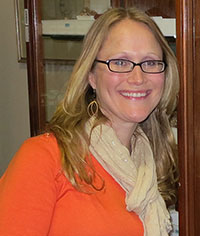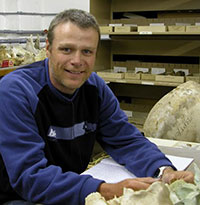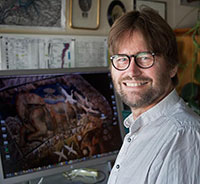 Juliet K. Brophy. Department of Geography and Anthropology, Louisiana State University, Baton Rouge, Louisiana and Evolutionary Studies Institute, University of Witwatersrand, Johannesburg, South Africa. jbrophy@lsu.edu
Juliet K. Brophy. Department of Geography and Anthropology, Louisiana State University, Baton Rouge, Louisiana and Evolutionary Studies Institute, University of Witwatersrand, Johannesburg, South Africa. jbrophy@lsu.edu
Juliet K. Brophy is a Biological Anthropologist with a specialization in Paleoanthropology. Juliet received her Masters degree from the University of Tennessee and PhD from Texas A&M University. Currently, she is an Assistant Professor at Louisiana State University in Baton Rouge, Lousiana and Research Affiliate and Rising Star Associate in the Evolutionary Studies Institute at the University of the Witwatersrand. Her particular research interests involve using morphometric analyses to examine taxonomic differences among Plio-Pleistocene fossil hominins and evaluate phylogenetic hypotheses regarding their evolution. Specifically, she employs a two-dimensional morphometric tool, Elliptical Fourier Function Analysis (EFFA), to quantify and identify species-specific dental characteristics. She is one of the dental morphologists investigating the teeth of South African hominins including Australopithecus sediba from the site of Malapa and Homo naledi from Dinaledi. She is also interested in documenting the paleoenvironments associated with the South African hominins and assessing how changes in these environments might have influenced hominin evolution. She is currently the Director of Bovid Studies at the Institute of Human Evolution, University of the Witwatersrand, Johannesburg for Malapa. She has been involved in excavations at several fossil localities in South Africa including Plover’s Lake, Coopers, and Gladysvale Cave and, at present, Juliet is senior research assistant in charge of field operations at the early Pliocene site of Matjhabeng in the Free State of South Africa. In addition to her excavation experience, Juliet is also interested in and has performed studies on the taphonomic effects of hominin and carnivore activities on patterns of bone fragmentation.

 Darryl J. de Ruiter. Evolutionary Studies Institute, University of Witwatersrand, Johannesburg, South Africa and Department of Anthropology, Texas A&M University, College Station, Texas. deruiter@tamu.edu
Darryl J. de Ruiter. Evolutionary Studies Institute, University of Witwatersrand, Johannesburg, South Africa and Department of Anthropology, Texas A&M University, College Station, Texas. deruiter@tamu.edu
Darryl de Ruiter is a paleoanthropologist in the Department of Anthropology at Texas A&M University in College Station, Texas. Originally from Canada, Dr. de Ruiter received his Masters degree in Anthropology at the University of Manitoba in 1995. The following year he moved to South Africa to continue his studies at the University of the Witwatersrand, receiving his PhD from the Department of Anatomical Sciences in 2001. He was employed as a Research Officer in the Bernard Price Institute of the University of the Witwatersrand from 2001 until 2003, when he moved to his current position in Texas. In 2009 Dr. de Ruiter was promoted to Associate Professor and was selected as a ‘Ray A. Rothrock’ Fellow in the College of Liberal Arts at Texas A&M. In 2013 Dr. de Ruiter was promoted to the rank of Professor, and in 2014 he was appointed as a Cornerstone Faculty Fellow in Liberal Arts at Texas A&M. Dr. de Ruiter was also appointed as an Honorary Reader in the recently established Evolutionary Studies Institute of the University of the Witwatersrand, and he maintains close collaborative ties with his friends and colleagues in South Africa. His current research focuses on the fossil hominins of South Africa, in particular Australopithecus sediba from Malapa and Homo naledi from Dinaledi.

 Mikael Fortelius. Department of Geosciences and Geography, Institute of Biotechnology; Finnish Museum of Natural History. mikael.fortelius@helsinki.fi
Mikael Fortelius. Department of Geosciences and Geography, Institute of Biotechnology; Finnish Museum of Natural History. mikael.fortelius@helsinki.fi
Mikael Fortelius is a palaeontologist with a long-standing interest in how mammalian teeth work, grow, and evolve, and how understanding teeth can help us understand the past, present, and future states of the world. He is Professor of Evolutionary Palaeontology in the Department of Geoscience and Geography at the University of Helsinki and Kristine Bonnevie Professor at the University of Oslo. For the last 20 years he has been engaged in developing and using the NOW database of fossil mammals (www.helsinki.fi/science/now/). His past work has been
strongly centered on the last 20 million years of climate change and mammal evolution in Eurasia. He is the inventor, together with Nikos Solounias, of the mesowear method of palaeodiet reconstruction. Photo by Ari Aalto.

 Marion Bamford. Evolutionary Studies Institute and School of Geosciences, University of Witwatersrand, Johannesburg, South Africa. marion.bamford@wits.ac.za
Marion Bamford. Evolutionary Studies Institute and School of Geosciences, University of Witwatersrand, Johannesburg, South Africa. marion.bamford@wits.ac.za
Marion works on a wide range of fossil plants from the Devonian to the Holocene in Africa. She specialises in fossil woods from the Permian, Cretaceous, and Cenozoic but she also studies fossil leaves, seeds, charcoal, and microfossils. Current multidisciplinary projects include the vegetation and palaeoenvironments of Sterkfontein, Wonderwerk, Sibudu, and Border Caves in South Africa, Olduvai, and Laetoli in Tanzania, and Rusinga, Koobi for a, and Lukeino in Kenya. She supervises post graduate students and lectures at Wits University.

 Lee R. Berger. Evolutionary Studies Institute, University of Witwatersrand, Johannesburg, South Africa. profleeberger@yahoo.com
Lee R. Berger. Evolutionary Studies Institute, University of Witwatersrand, Johannesburg, South Africa. profleeberger@yahoo.com
Prof. Lee R. Berger Ph.D. D.Sc. FRSSAf ASSAf is an award-winning researcher, explorer, author, and speaker. He is the recipient of the National Geographic Society’s first Prize for Research and Exploration and the Academy of Achievement’s Golden Plate Award. His work has brought him recognition as a Fellow of the Royal Society of South Africa and the South African Academy of Sciences and prominent advisory positions including the Chairmanship of the Fulbright Commission of South Africa, the Senior Advisory Board of the Global Young Academy and the Centre of Excellence in PalaeoSciences of South Africa among many others. He is a South African Ambassador for Tourism, Conventions and Business Events. He has been awarded several humanitarian awards including the Boy Scout Medal of Honor for saving a life and the Red Cross Certificate of Merit. In addition his efforts in conservation have been recognized by the William T. Hornaday Award and Georgia’s Youth Conservationist of the Year. His explorations into human origins on the African continent, Asia, and Micronesia for the past two and a half decades have resulted in many new discoveries, including the discovery of two new species of early human relatives – Australopithecus sediba and Homo naledi. His contributions to exploration sciences have also resulted in advances in the field of applied exploration methods and the application of technology to exploration, excavation, and discovery. He is the author of more than 200 scholarly and popular works including more than 100 refereed papers and a number of academic and popular books on palaeontology, natural history, and exploration. His work has been featured three times on the cover of Science, and has been named the top 100 science stories of the year by Time, Scientific American and Discover Magazine on numerous occasions. He has appeared in many television documentaries on subjects related to archaeology, palaeoanthropology and natural history. Berger is an internationally recognized proponent of open access science and open sourcing. He has founded the not for profit Lee R. Berger Foundation for Exploration and was a founder of the Palaeoanthropological Scientific Trust and a founding Trustee of the Jane Goodall Society of South Africa. He is Director of both the Malapa site and Rising Star excavations, the latter resulting in the discovery of the largest primitive hominin assemblage in history. He is an avid diver and adventurer and holds a PADI Divemaster certificate among many other specialties. Berger was born in Shawnee Mission Kansas and grew up in rural Georgia. He was awarded his Eagle Scout in 1983 achieving his silver and gold palms and has been recognized as a Distinguished Eagle Scout by the Eagle Scouts Association of America. Berger is presently the Research Professor in Human Evolution and the Public Understanding of Science at the University of the Witwatersrand, Johannesburg, South Africa and an Explorer in Residence at the National Geographic Society. He is also the Division Director of Palaeoanthropology in the Evolutionary Studies Institute at the University of the Witwatersrand. He holds a Ph.D. in palaeoanthropology and a Doctor of Science in the same field.

